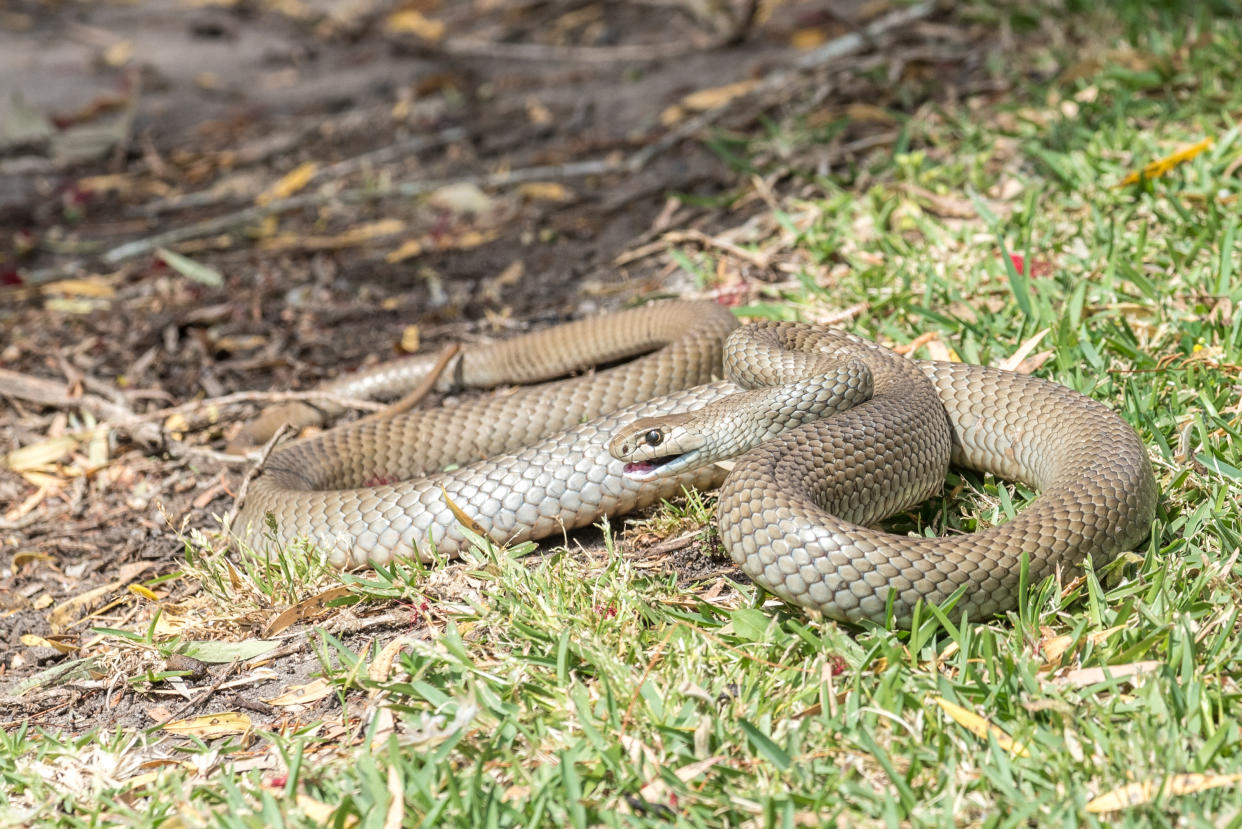Snake bites are on the rise — here's what parents should know

It’s the summer of the snake — the reptiles are slithering in droves and biting in increasing numbers.
A 17-year-old boy from Jacksonville, Fla., was hospitalized for seven hours last week after getting bitten by two snakes while mowing a lawn. “They suspect it’s some sort of rattlesnake because of how high it bit me up on my leg,” victim Connor Stoll told local news station News4Jax about the two bites on his calf. “I fell to the ground, and I went over and moved to our truck, just sat there and tried to stop the bleeding from my leg.” Stroll was fortunate that venom did not enter his body.
However, a 2-year-old girl from Oklahoma wasn’t as lucky — earlier this month while playing under a tree at her grandparents’ home in the early evening, Finley Roth was bitten by a copperhead snake. Mom Jillian told Fox 23 that her daughter made a “small cry,” and her foot “just kept getting bigger by the second” while turning purple.
Well it’s been a few months since the last visit so it was only time before Finley came back to her 2nd home! She got…
Posted by Jillian Roth on Monday, July 2, 2018
The girl was hospitalized at Children’s Hospital at St. Francis in Tulsa, according to a Facebook update from Jillian, who vowed to go “snake hunting” and kill whatever lurked on the property. Since the bite, Finley’s grandfather has killed 17 snakes near his home.
In August 2017, Meg Trammell, an 11-year-old girl from Birmingham, Ala., left her house to walk her dog when she heard a rustle in the bushes and felt something zap her toe, a sensation comparable to a bee sting. “I immediately started crying,” Meg told CNN. “I thought: ‘A snake bit me and I’m gonna die!’” After spotting fang marks, Meg’s parents called 911, and later police identified the snake as a copperhead.
According to the Centers for Disease Control, every year 7,000 to 8,000 people in the United States are bitten by venomous snakes (mostly rattlesnakes, copperheads, water moccasins, and coral snakes), and five of those people die. A 2016 study published in the journal Pediatrics also found that more than 1,300 children are bitten each year across the United States (often by copperhead snakes), with the majority of victims boys and the average age of the child 10.7 years old. While bites occur every month, they’re more common in the summer.
Though snakes don’t seek to bite humans, when they’re startled or feel threatened (typically from being stepped on or poked, or by hearing loud noises), they strike quickly, due in part to skin color that often blends with their wooded, grassy environments. Some are brightly colored, but others are nearly impossible to spot — in 2017, a PhD student in Florida tweeted a viral photo of a snake in plain sight and challenged her followers to find it, with many failing at the task.
Received this from a fellow HERper this morning. No caption needed, the task was implied: "can you spot the snake?" 🐍 pic.twitter.com/oVkjOm8ufy
— Helen P. 🐍👩🏼?🔬 (@SssnakeySci) April 23, 2017
If y'all haven't found it yet… Copperhead, aka Agkistrodon contortrix. Cute but venomous, so no touchy! ??🐍?? pic.twitter.com/pSVMIhFP0o
— Helen P. 🐍👩🏼?🔬 (@SssnakeySci) April 24, 2017
“Bites increase during the summer when snakes come out to essentially sunbathe and people spend more time outdoors,” Julie Weber, director of the Missouri Poison Control Center, tells Yahoo Lifestyle, adding that in warmer states, they’re present year-round. Snakes don’t bite children more often than adults; however, kids might be less aware of their surroundings and more hands-on with their environments.
“You’ll know a snake is poisonous if the head is shaped like an arrow — these are called pit vipers — and if they have fangs,” she says. Although snakes usually strike and leave before a person realizes what has occurred, bites can also be “dry,” due to a lack of venom at that particular moment, as in the case of Connor Stoll.
Weber says the best way to treat a bite is to stay calm, then wash the area with soap and water, hand sanitizer, or baby wipes. “We don’t recommend icing the area or you’ll risk blood constriction, which can concentrate the venom.” Also, do not suck out venom, which can transfer bacteria from the mouth to the bite, or use suction kits, which aren’t proven effective, or apply tourniquets, which can cut blood supply.
“The best thing to do is call the poison helpline, which connects people to local control centers,” says Weber. “That’s important because, for example, a bite from a copperhead snake in Missouri is treated differently than one in Alabama.” Specialists will ask questions to provide the best treatment or contact 911.
“Also, never try to kill the snake,” says Weber. “Their reflexes are active even when dead, and a snake that is chopped in half can bite again.”
Well, that’s terrifying.
In case of possible poisoning, call the national Poison Help hotline at 800-222-1222 or text POISON to 797979 to save the number in your phone.
Read more from Yahoo Lifestyle:
Horrific Accident Underscores Dangers of Baseball and Softball Games for Kids
The terrifying moment a child was almost crushed by a chest of drawers was caught on CCTV
Follow us on Instagram, Facebook, and Twitter for nonstop inspiration delivered fresh to your feed, every day.
